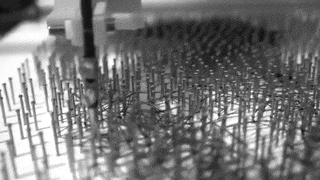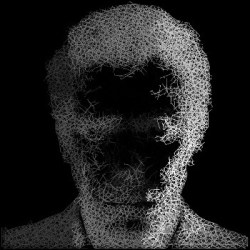“String Art” is the name of the art form that transforms thousands of nails and just as many feet of thread into unique masterpieces. Some artists have developed techniques to create photorealistic string art works, but until now, there was no way around the tedious and time-consuming manufacturing process. Depending on the size, it can take months to complete a single piece by hand.

Now, you might think, wouldn’t it be great to build a sophisticated “nail and thread”-machine that takes care of the whole assembly process, from placing the nails on the board to winding the string around the nails? The people behind Laarco, a design studio in London, UK, did exactly that. Their project “Autograph” is effectively a large scale “printer” for string art, capable of satisfying the increasing demand for this form of image reproduction.
While they are not shy to show their amazing results, mostly string-art-converted photographs of celebrities, we will probably not get a full documentation on the hardware and software behind Autograph. After all, it took them four years of development to build this fully automated machine, and they are about to turn their string boss-ness into a strong business: You can now buy their unique string art pieces starting at $1,100.

Too expensive? Well, you can still build your own: The brain of the machine is a Raspberry Pi which sends commands to an Arduino Mega equipped with a 3D printer shield. The gantry design looks very similar to a popular low-cost CNC-mill, however, they added a custom tool head to position and uncoil the thread while keeping it under tension.
In preparation of an assembly pass, the nail positions are derived from Voronoi diagrams, an unknown mechanism then picks and places the nails into pre-drilled holes. During the threading run, the height of the tool head increases as the process progresses to avoid collisions with previous string segments.
We’ve seen drawing-bots, polar graphs and robotic artists in various forms in the past, but it’s probably safe to say that this is the first string art machine ever built. That said, enjoy the video:
















Impressive
“The gantry design looks very similar to a popular low-cost CNC-mill”.
Which mill is that?
looks like shapeoko
It’s an eShapeOko, a version of the ShapeOko by http://amberspyglass.co.uk/.
Shapeoko 2 i guess.
I’d say the portal is borrowed from an X-Carve, looks like they replaced the beam, though.
It’s an eShapeOko, from amberspyglass.co.uk.
thanks! It seems to range from £270 to £400, which is not too bad..
Does anybody have any idea to what tolerance this eShapeoko CNC can cut wood? And how deep?
“string boss-ness into a strong business” Now that’s some writing style! Nicely done.
I loved that as well. Came out of nowhere and left me smiling.
Very impressive!
If I were going to try and put that many nails in a board I would mill each hole with a short counterbore with a slip fit diameter. That way, once the milling is done, I can quickly place and orient all the nails, then come through and hammer them in a few more mm into the smaller diameter pilot.
Also, I doubt the nail placement is just a Voronoi algorithm. Center of mass Voronoi tends to place points in a line, which is not optimal in very dark areas for this thead tequnique.
Their site says nail placement is done “using corner and edge detection algorithms and voronoi diagrams to fill empty areas in a natural and pleasing way.”
I suspect that means the nails that make up the image are done with corner and edge detection, leaving voronoi algorithms for just the space filling. If I were the then venture an artistic and mathematical guess, I would guess that the voronoi algorithm isn’t done in Euclidean distance, but maybe Mahalanobis.
I am impressed when a human makes wonderful string art. But if a machine does it…
You’re superimpressed?
The machine is the work of art. The output is bonus.
Hmm. How to do color? Multiple strings or perhaps dynamically apply dye during the process?
yeah, my thought was as well: it wouldn’t be much harder to work with colored strings, would it?
It depends on whether it uses multiple bobbins and can change them without human interaction.
Or maybe EL wire?
When wire wrappers get bored :D
Does it drill the holes too?
This is extremely impressive. Awesome.
Even though I’ve been thinking about it since this was posted, I can’t find an algorithmically pleasing way to finding the path to wrap the wire, any ideas on how they do it?
My grandma said “Oh look at that lovely embroidery.”
Do they sell the machines? Lol. I run a string art business and this would be incredible!